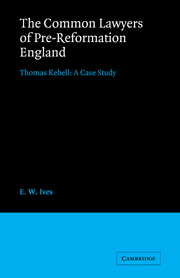Book contents
- Frontmatter
- Contents
- List of figures and tables
- Preface
- Abbreviations
- Manuscript sources
- Table of cases
- Introduction
- PART I THE LEGAL PROFESSION
- PART II LEGAL PRACTICE
- PART III THE LAWYERS AND THE LAW
- PART IV THE PROFESSION AND SOCIETY
- 13 The rewards of the profession: fees and payments
- 14 The rewards of the profession: income and morality
- 15 The rewards of the profession: the estates of Thomas Kebell
- 16 The rewards of the profession: Humberstone Manor
- 17 Social mobility: the Kebells of Humberstone
- 18 Thomas Kebell and the pre-Reformation legal profession
- Retrospect
- Appendices
- Index
Retrospect
Published online by Cambridge University Press: 05 November 2011
- Frontmatter
- Contents
- List of figures and tables
- Preface
- Abbreviations
- Manuscript sources
- Table of cases
- Introduction
- PART I THE LEGAL PROFESSION
- PART II LEGAL PRACTICE
- PART III THE LAWYERS AND THE LAW
- PART IV THE PROFESSION AND SOCIETY
- 13 The rewards of the profession: fees and payments
- 14 The rewards of the profession: income and morality
- 15 The rewards of the profession: the estates of Thomas Kebell
- 16 The rewards of the profession: Humberstone Manor
- 17 Social mobility: the Kebells of Humberstone
- 18 Thomas Kebell and the pre-Reformation legal profession
- Retrospect
- Appendices
- Index
Summary
At the outset of this study three areas were identified where a legal profession may have significance–impact upon the law, a role as a managerial group, and influence upon society. Each can be demonstrated to an abundant degree in the England of the Yorkist and early Tudor kings.
Of the three, it is the last which catches the eye. The law precipitated social mobility. It was the safest and most convenient way for a family to acquire free capital for investment in land or on the marriage market. Entry into the law also brought membership of a group which was socially advantageous, thanks to its internal cohesion and its wide connections. That this did not lead to the English profession following the noblesse de robe is explained by the continuing ties which a lawyer had with his home or adopted community, and by the openness of English society, which enabled a family to abandon the law after one or two generations and become indistinguishable from less aspiring or less adventurous representatives of the gentry. A profession in terms of both status and organisation, and with the added characteristics of much intermarriage and business cooperation, the lawyers nevertheless did not become a caste.
Principal importance, however, must belong to the first of the areas identified, the relations between the profession and the law. The lawyers of Kebell's time were in at the start of a reform which enabled the law to meet the new problems of the day and so, unwittingly, they saved for the world the distinctive procedures and doctrines of the English common law.
- Type
- Chapter
- Information
- The Common Lawyers of Pre-Reformation EnglandThomas Kebell: A Case Study, pp. 418 - 422Publisher: Cambridge University PressPrint publication year: 1983

